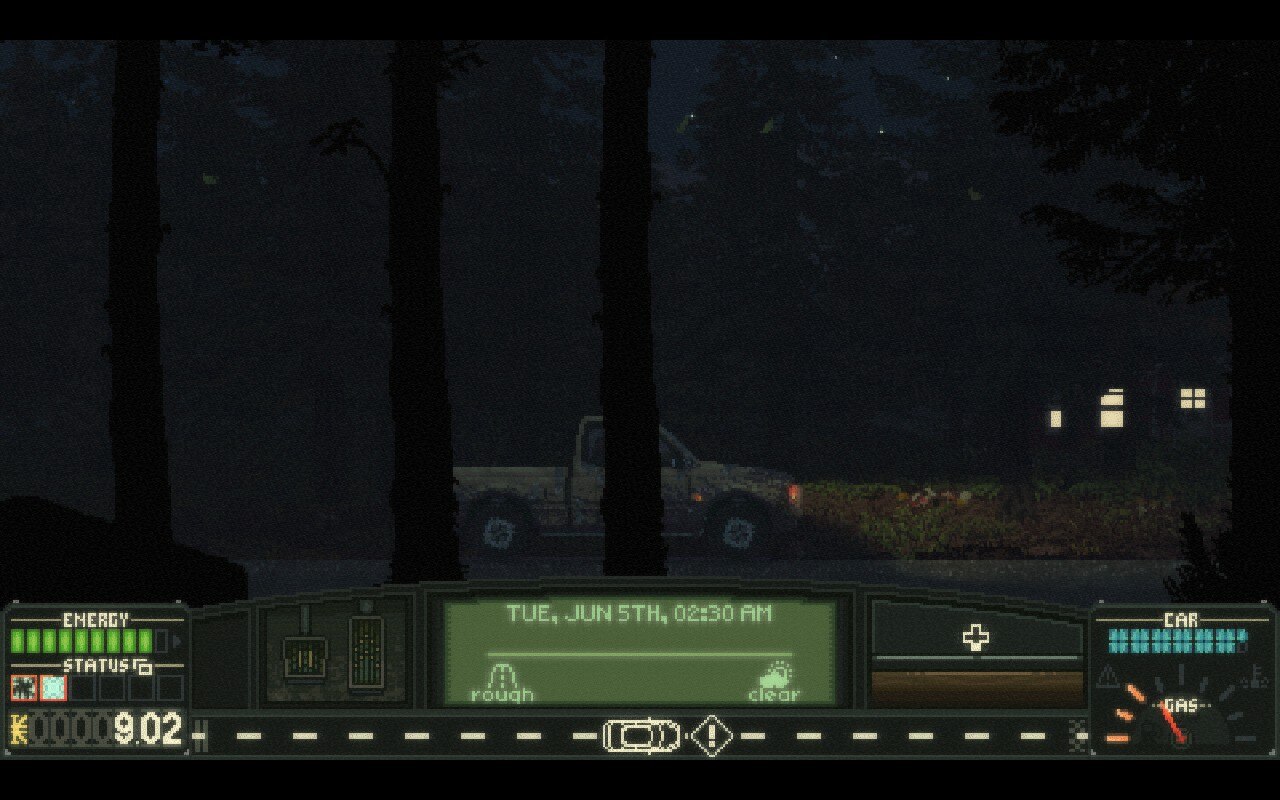
OK, don’t let the title scare you. I know it sounds a bit… trendy, and I’m sorry. But I promise I’ll try―or try to try―not to get too heady in this “review” of Y/CJ/Y Games’s Keep Driving.
I know it’s been a minute since I’ve posted on the blog. The lapse started when I couldn’t come up with something immediately that I wanted to write about. It kept going as I went on a couple of back-to-back vacation trips with my family. Now I’m back, after having driven on some rural roads and infamous beltways (a rare occurrence for my typical public transportation/bike riding city-living). And coincidentally, during this time of travel, I was also playing through Keep Driving, an “atmospheric management RPG” (according to the Steam page) about a road trip to meet up with friends at a not-to-be-missed music festival.
The game loop is fairly simple: you start at your house, load up your car, and start driving towards the festival destination across the map. As you drive, you encounter “challenges” that you must overcome to reach your next stop (or choose to run away from with added penalties). These obstacles can range from fending off a bee in the car, traffic jams, or herds of sheep blocking the road. But each challenge comes with a set of icons that you must match with skills or items you’ve acquired on your travels. Along the way, you can also pick up hitchhikers who can help clear challenges with their own skills (and complications) as well as give you additional side-missions to complete on your trip. If you cannot clear the icons, you can take “damage” to your social meter, your car’s durability, your gas tank, or your wallet. Strategizing how you employ your skills, use items, and maintain cash flow to clear challenges to progress along the road while managing any debuffs that crop up along the way (like tiredness, hunger, sadness, dirtiness) is the central crux of the gameplay.
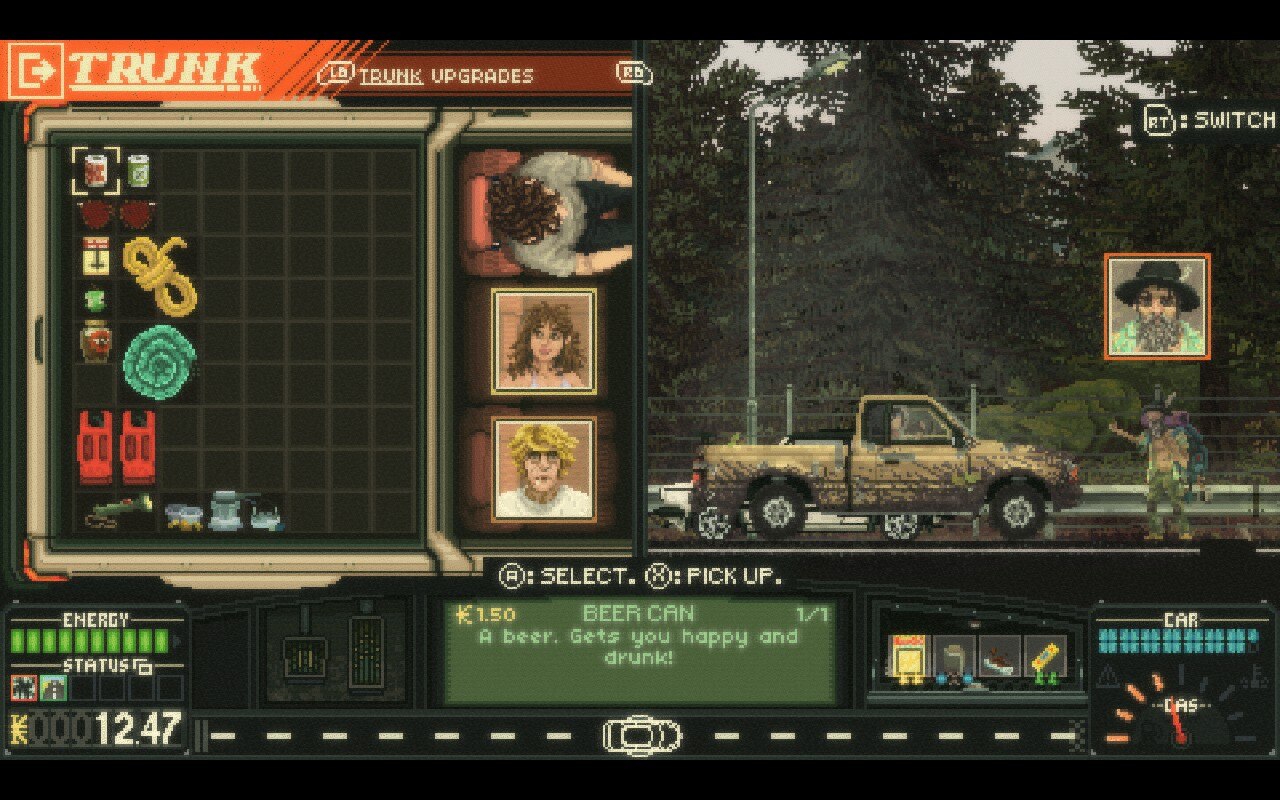
But the above description kind of skips over what’s so satisfying about Keep Driving (though the mechanical execution is very polished). It’s that the game nails the emotional highs and lows of hitting the road with limited resources and abundant expectations. You feel the scarcity and risk of your adventure, not from a statistical chance or probability calculator, but from your GUT. You watch your gas meter flash as your tank nears empty, or misjudge how many skills you have left to use and wish you had rested at the last town. I constantly felt broke, searching for opportunities to find/sell scrap, praying for abandoned cars (one of the challenges you encounter on the road) that might have an extra jerrycan, or plotting a course to the nearest work opportunity.
All of these gameplay elements immediately brought me back to my driving trips: back to a mindset where you’d measure distance by gallons rather than miles, or keep track of your budget by how many gas station hotdogs you could afford before you spent the night crashing on the couch of a distant relative. Keep Driving captures those moments―that way of thinking and being―so well that it instantly made me reminisce about the cross-country road trip I made the summer before going to college. Or the time I drove my parents’ car from DC to Colorado and stuck my head out the window to keep myself awake before reaching some far-flung, random KOA in Nebraska in the middle of the night. Or even taking the local EuroRail trains (I know, not driving, but still) from Prague to Berlin and having to sit in the aisle because I didn’t pay for a reserved seat (or because I didn’t understand how to do so because I was―am―a stupid American).
And this is where I’ll come back to my (maybe not so provocative) title: Keep Driving is a quintessential vibes game. Again, its mechanics are very well tuned, and the bits of storytelling/narrative are executed with a light, but effective, touch. But describing these, or trying to translate these into the intangibles of the game, is pretty difficult, and even harder to analyze. It’s because the game taps into direct experience. Yes, it’s a simulation management game, but it’s clearly made by people who have done exactly this kind of trip multiple times and have worked exceedingly hard at crafting something that pulls directly from those emotions and experiences. It’s a game that feels like a diary, but without a strong central protagonist, so the player plops themselves into the driver’s seat seamlessly. Because the vibe is so strong, it’s hard not to become personally attached to your trip.
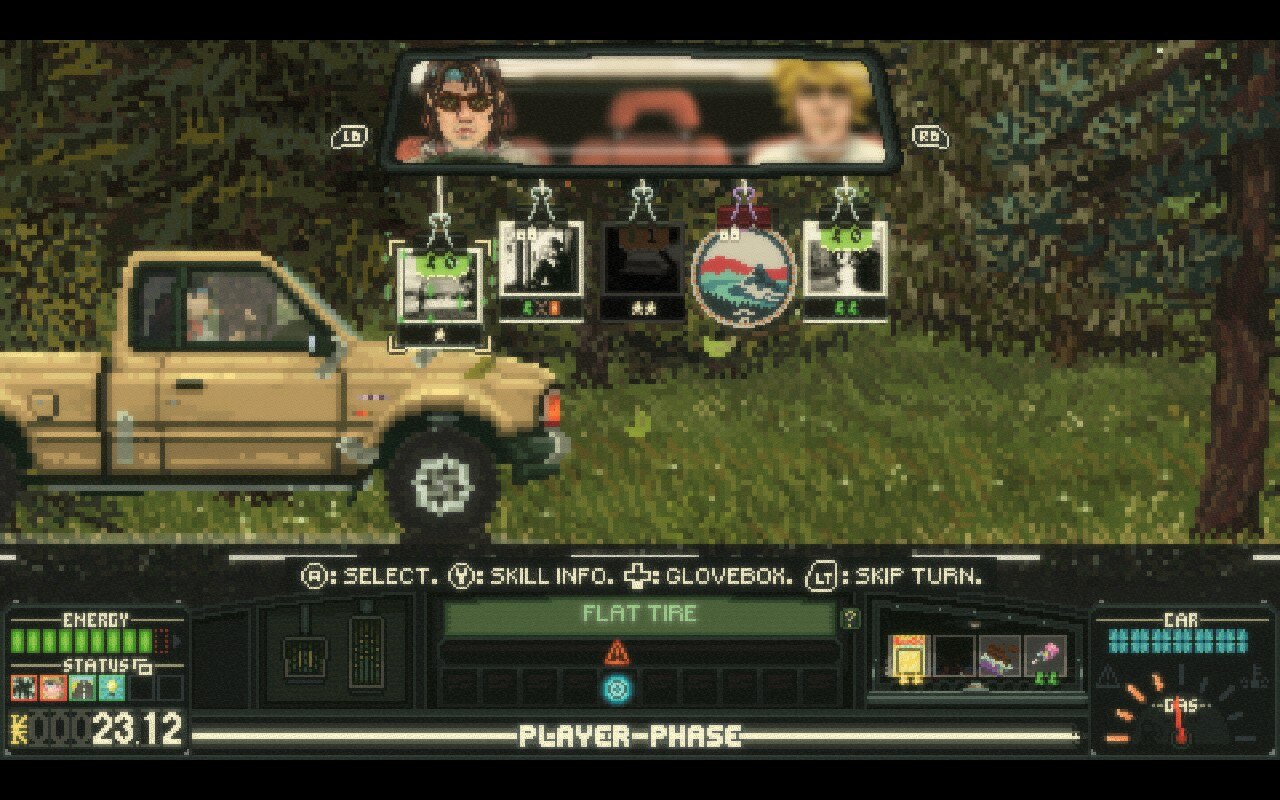
Why this might be of interest for narrative designers and writers is that the storytelling doesn’t primarily happen with the actual narrative or plot of the game, but rather through its vibe. Instead of telling or describing what it feels like to go on a road trip, Keep Driving articulates these emotions through its atmosphere and setting. Feelings of desperation, anxiety, joy, calm, confidence, and anticipation are all brought about not by NPCs chattering or internal monologue, but instead by finely tuned systems operating in harmony. From a narrative design perspective, it’s an incredibly good case study in using a “light touch.”
If, for instance, there were sections of the game where the protagonist had poetic soliloquies dripping with profound statements about the open road, the game’s vibe would instantly be thrown off. Similarly, if the hitchhiker dialog wasn’t so curt and intermittent, it would interrupt your headspace, cluttering it with distractions, preventing you from just enjoying the ride. But the designers understood that some thematic direction was necessary, and opted for a simple, but highly effective, technique that I deeply appreciated: branching introspection.
Some challenges along your route offer opportunities for you to reflect on your trip. These occasionally trigger specific buffs or conditions that can affect your playthrough in a myriad of positive and negative ways. But the invitation to take a moment to think about your situation, of your own experience, is something that guides the vibe of the game and likewise shapes (ever so subtly) the narrative, even if just for yourself. Because this kind of driving is deeply contemplative. The monotony, the repetition, the calming sensation of looking out onto a stretch of countryside, the latent Romantic sublimity found in the vastness of an open road, all lead one toward interiority. Road trips are inherently introspective, and Y/CJ/Y capture that ingrained sentiment so seamlessly.
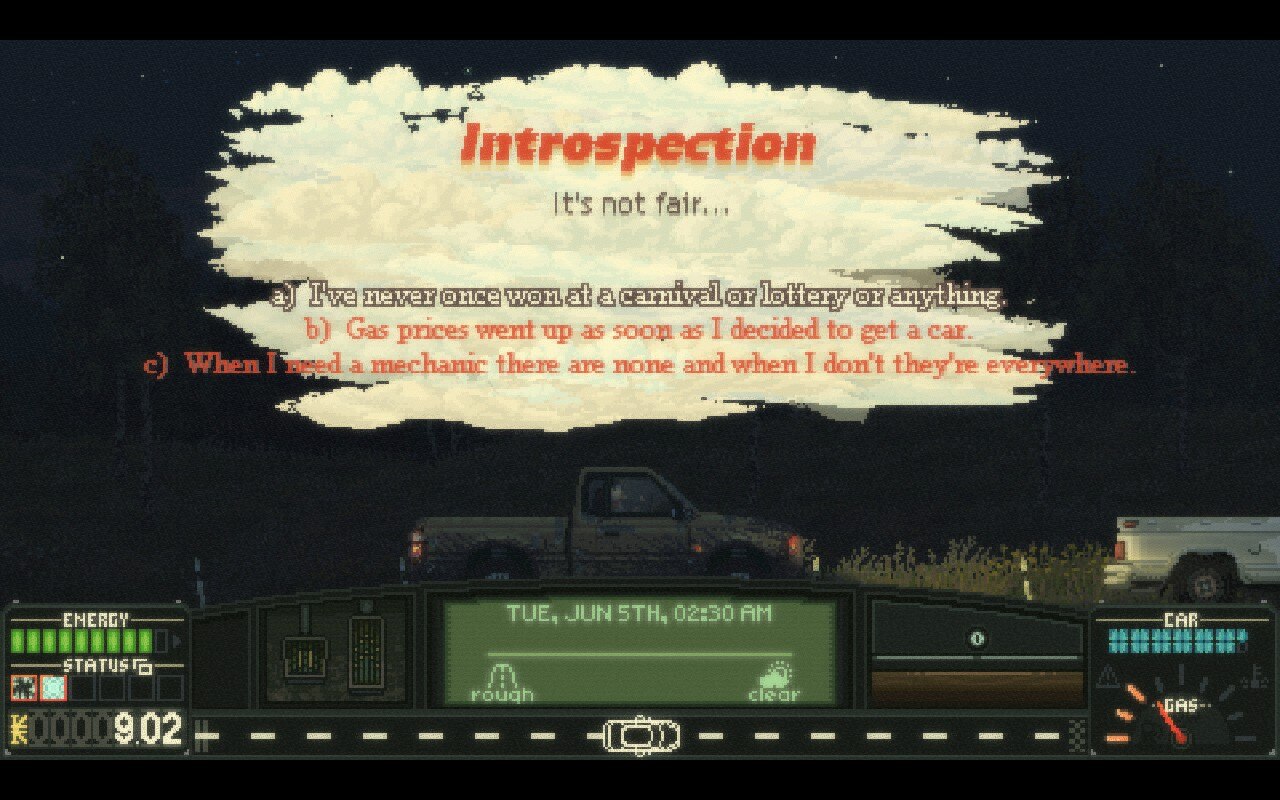
This isn’t to say that Keep Driving is perfect. There are moments when the interface feels clunky (or it did on my SteamDeck), and where overlays still allow you to access menus below―leading to frustrating UI/UX issues. There are moments where the skills-to-challenge balance feels a bit off or unreasonably punishing. But even in those instances, there are lots of “opportunities for forgiveness,” and the overall difficulty ceiling never feels too overwhelming. And, more importantly, even when you do reach moments of failure or missed strategic plays, the game gently reminds you that the point is the journey, not the destination (a cliché which the devs BARELY avoid).
In many ways, one could easily “run” this game over and over to find optimization strats, or most reliable “builds” (which I’m sure has occurred, because y’know… gamers). But I think doing so would miss the point of the game entirely. It’s a game that very pointedly and smartly employs very familiar (and currently popular) genre motifs, but successfully detours around prodding the player toward completionist gamer tendencies. Yet another reason it’s a vibes game: it leverages design conventions not to bolster a flimsy premise, but to get you into a specific emotional and psychological headspace. Players quickly understand the mechanical expectations and variables of the game, but never feel compelled to master them (or else mastery is completely beside the point). In this way, it’s very “easy” to get into a flow state and to find yourself performing the mental equivalent of having your hand drift along the breeze whipping past the passenger window.
But perhaps the most vibe-y aspect of the design that really drives home (forgive the pun) Keep Driving‘s aesthetic is its soundtrack. For nothing dictates vibes more than music: nature’s most abstract, yet most arresting art form. Not only is the starting CD given to the player such a mood setter, but the entire catalog of collectable tracks, singles, albums, and songs all reinforce the underlying DIY, seat-of-the-pants, alt-punk, cavalier yet self-conscious feel of the game. It’s so fitting that the soundtrack plays an outsized role in this work, because that’s exactly how mix CDs/tapes/playlists work on roadtrips: they literally set the tone.
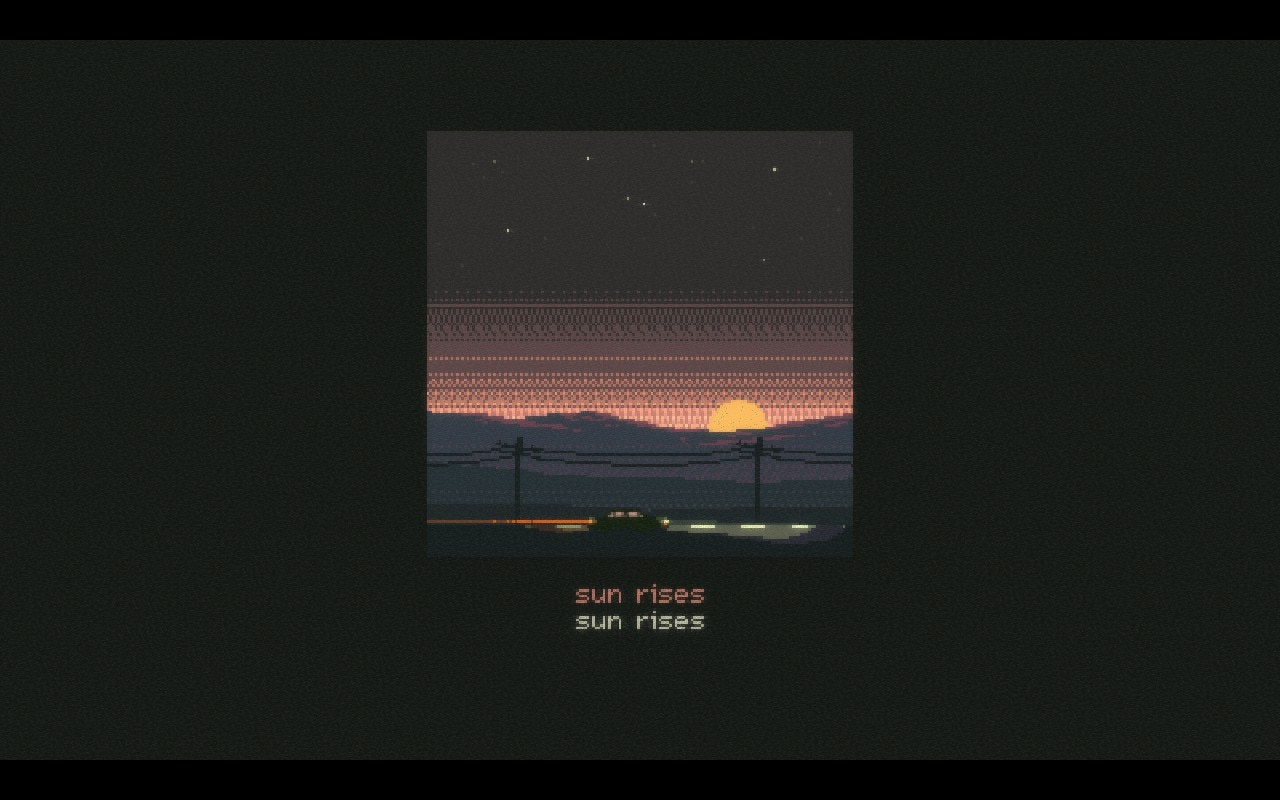
I’ll stop here and encourage readers to see (and hear) for themselves how Keep Driving‘s vibe is undeniable, earnest, engaging, and fun. As a parting note, I’ll say that it’ll probably end up in my Top 5 games of the year (which might be an actual thing I publish this year… who knows!).
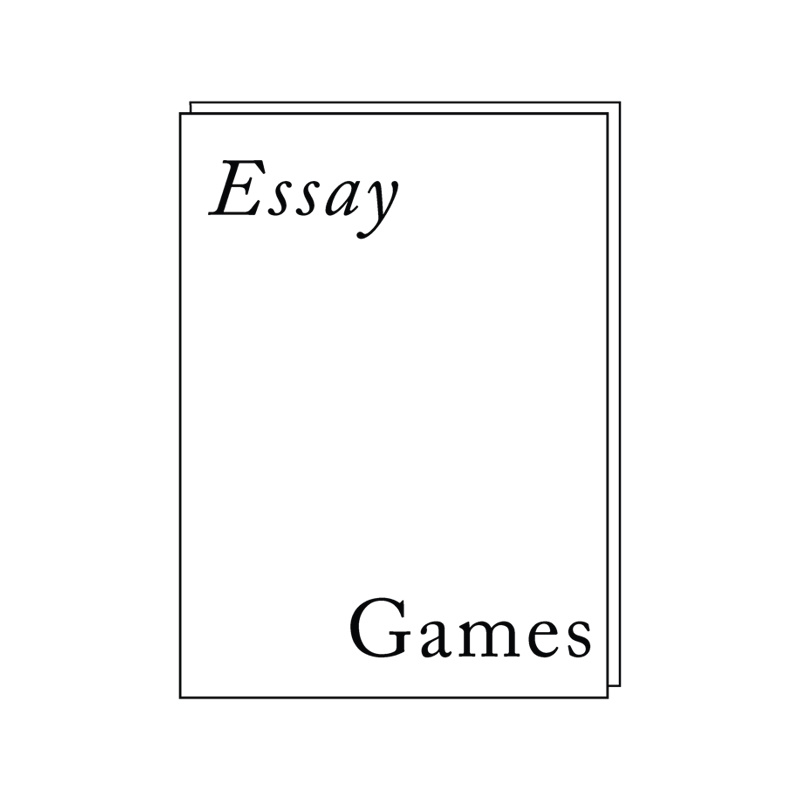
Leave a Reply